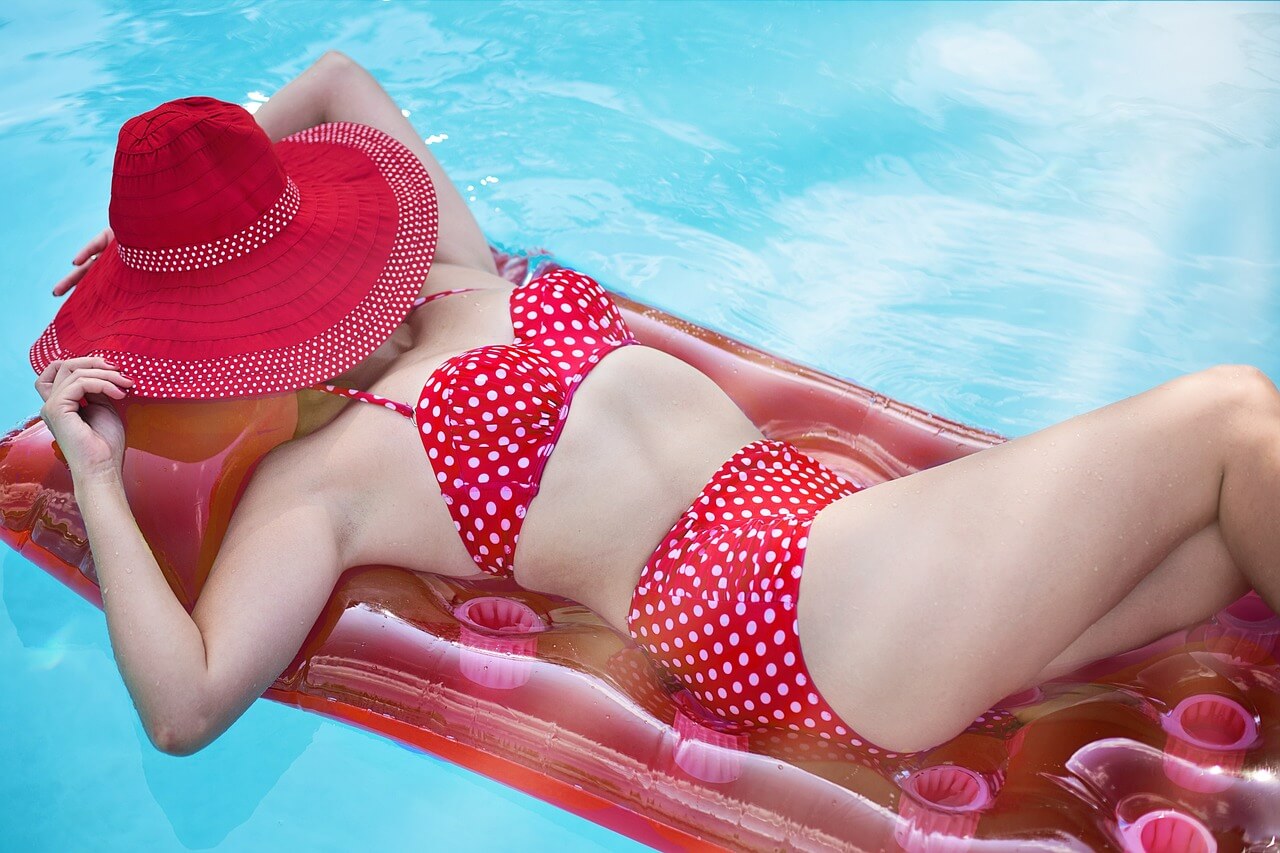Picture this: it’s a hot summer day and you’re ready to relax by the pool, but you don’t have a pool float to lounge on. Suddenly, you remember your trusty air mattress tucked away in the closet. You wonder, “Can an air mattress float on water?” Well, you’re in luck. Using an air mattress as a pool float is not only possible, but it can also be a fun and unique way to enjoy the water.

Typically, an air mattress is just a sack filled with air, making it able to float on water without much trouble. However, before you start using your air mattress as a pool float, there are a few factors to consider. For example, if your mattress has a suede top layer, you should know that water may damage it.
Additionally, the air mattress must be large enough to support your weight and you should keep it from abrasive surfaces or sharp objects to avoid punctures. Should you puncture it, you can always patch it up with some marine epoxy resin and duct tape.
While using an air mattress as a pool float may seem like an unconventional idea, it can be a decent alternative when you’re short on pool toys or simply want to add some creativity to your poolside activities. So grab your air mattress and enjoy the sun, fun, and possibility of making a splash at your next pool party!
Air Mattresses Vs. Pool Floats

In this section, we will compare air mattresses and pool floats, discussing their material differences, design, and shape differences, as well as their buoyancy.
Material Differences
Air mattresses and pool floats are made from different materials, which affect their durability and comfort. Air mattresses are usually constructed from PVC or vinyl, which makes them more durable and resistant to punctures. However, water can still affect the top suede layer of the mattress.
On the other hand, pool floats are typically made of lighter materials, such as EVA foam or inflatable plastic. These materials are specifically designed for use in water and provide a more comfortable floating experience.
With that said, some pool floats are also made with PVC, so there is an overlap in this area, which is part of the reason why air mattresses and pool floats are sometimes compared. We talk more about this in a section below.
Design and Shape Differences
Air mattresses and pool floats also have distinct designs and shapes tailored to their intended purposes. Air mattresses are usually rectangular, flat, and built for sleeping, making them suitable for lounging on top of the water with.
Pool floats, on the other hand, come in a wide variety of designs, shapes, and sizes, such as loungers, tubes, and animal shapes that are designed for leisure activities in the water.
Buoyancy
The buoyancy of an air mattress and a pool float can differ due to their construction and materials. Air mattresses are typically thicker and have more air chambers, which can make them more buoyant.
Pool floats, often being much smaller than an air mattress, may be less buoyant compared to air mattresses. However, they can come in various shapes and sizes that can make them more enjoyable to lounge on in the water.
With that said, pool floats can also come in larger sizes that rival or exceed an air mattress, so overall it is the superior option for lounging in the water.
Chlorine Resistance
Some air mattresses and many pool floats are made with polyvinyl chloride (PVC). This material has inherent resistance to oxidative degradation by chlorine solutions and can be made more resistant to chlorine through the addition of stabilizers, but it is still subject to degradation over time.
While PVC is resistant to chlorine, air mattresses in particular are not designed to be used as pool floats or to come into contact with chlorine on a regular basis. The long-term effects of exposure to chlorine on an air mattress are not clear, and chlorine could cause damage or degradation to the PVC material over time.
Safety Considerations
Stability Issues
When using an air mattress as a pool float, be aware of stability issues. Unlike traditional pool floats, air mattresses are larger and can tip over easily if you put your weight all on one side. This can pose risks, especially for children or those who have difficulty swimming. Be cautious when getting on and off the mattress, and try to maintain balance by staying in the middle.
Air Leak Risks
Air mattresses can provide a fun and relaxing experience when floating in a pool, but consider the risks associated with air leaks. Even regular inflatable floats can experience punctures that cause air leaks. If an air leak occurs while you’re floating in the pool, the mattress could deflate rapidly, leading to a drowning risk.
Before using an air mattress as a pool float, inspect it for any signs of punctures and ensure that it is fully inflated. In addition, be cautious of sharp objects in and around the pool area which could cause punctures. If you notice any air loss while floating, return to the edge of the pool and exit the mattress immediately.
Using an Air Mattress as a Pool Float
Temporary Usage
While it’s true that air mattresses can be used as pool floats, you should keep in mind that they are not designed for this purpose. However, for temporary use, they can provide you with a fun and unique floating experience.
If your air mattress has a suede top layer, be aware that water might affect it. To avoid any damage, use a waterproof cover or opt for an air mattress without a delicate top layer. And always ensure adult supervision when children are using air mattresses as pool floats.
Pros and Cons
There are both advantages and disadvantages to using an air mattress as a pool float. Let’s explore them:
Pros:
- Air mattresses are usually larger and can comfortably accommodate your body.
- They are often more affordable than specialized pool floats.
- They can be inflated and deflated quickly, making them convenient for temporary use.
- Using an air mattress as a pool float adds a unique element to pool parties.
Cons:
- Not designed specifically for pool usage, which may affect durability.
- Air mattresses with a suede top layer can be damaged by water.
- They can be less stable than traditional pool floats.
As you can see, using an air mattress as a pool float has its ups and downs. However, if used responsibly and occasionally, it can serve as a fun and affordable option.
Alternative Options to Air Mattresses
I call them alternative options, but really these are the options that you should have started with.
Inflatable Pool Floats
A wide variety of inflatable pool floats are available on the market, ranging from simple ring-shaped floats to more unique and creative designs. These floats are typically made from durable, water-resistant materials like PVC, making them a great choice for lounging in the pool.
Inflatable floats offer numerous benefits such as easy storage when deflated, quick inflation process, and are available in different sizes, shapes, and themes. Keep in mind that some inflatables may require an air pump for inflation, while others can be inflated using your breath or a manual pump.
Foam Pool Floats
Another popular alternative is foam pool floats. These floats are made from lightweight and buoyant materials such as polyethylene foam. They come in various shapes and sizes, including loungers, noodles, and saddles.
Foam floats are known for their durability and resistance to punctures or tears, unlike their inflatable counterparts. Since they don’t require inflation, they’re ready to use immediately and can be easily rolled up for storage. Additionally, foam floats provide more stability on the water, allowing you to relax comfortably.
When choosing between inflatable and foam pool floats, consider factors such as your budget, storage space, and desired level of comfort. Both options can enhance your swimming pool experience, so pick one that best suits your preferences and enjoy your time in the water.
Parting Words
Using an air mattress as a pool float is definitely a fun and exciting idea for your pool parties or relaxing sessions in the water. Air mattresses are easily inflatable and add a unique element to your pool enjoyment.
However, remember that water can affect the top layer of the mattress, especially if it has a suede top layer. In such cases, you either have to be careful or be prepared to potentially damage the suede layer if chlorinated water gets on it.
When using an air mattress as a pool float, always prioritize safety. Ensure that it’s properly inflated and big enough for you to comfortably lie on. Furthermore, never leave children unsupervised on air mattresses in the pool.
So go ahead, grab your air mattress, and float your way to a fun experience in the water. Just keep in mind the tips and precautions discussed here to make the most of your floating adventure!
Sources:
- https://experthometools.com/can-you-use-an-air-mattress-as-a-pool-float/
- https://outdooralive.com/can-air-mattress-float-on-water/
- https://theoutdoorgoal.com/can-you-use-an-air-mattress-as-a-pool-float/
- https://bathingarena.com/can-you-use-an-air-mattress-as-a-pool-float/
- https://poolfloatlounger.com/can-you-use-air-mattress-as-pool-float/

